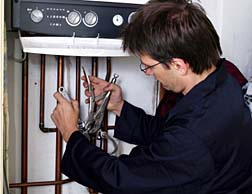And with fewer fittings, proponents say there are fewer installation errors. However, some of those fewer fittings have been known to fail prematurely, causing leaks and damage to homes.
 Zurn Industries LLC has been around for quite awhile, founded in 1900. It became a private company in February of last year, after Zurn was acquired by Rexnord LLC from Jacuzzi Brands. The company's product line is diverse, and while manufacturing PEX piping and fittings for decades, Zurn Industries Inc. takes credit for pioneering the first flexible residential plumbing system in the early 1970's. Originally used in RVs and mobile homes, the site-build home industry soon discovered the system and started using it in permanent structures.
Zurn Industries LLC has been around for quite awhile, founded in 1900. It became a private company in February of last year, after Zurn was acquired by Rexnord LLC from Jacuzzi Brands. The company's product line is diverse, and while manufacturing PEX piping and fittings for decades, Zurn Industries Inc. takes credit for pioneering the first flexible residential plumbing system in the early 1970's. Originally used in RVs and mobile homes, the site-build home industry soon discovered the system and started using it in permanent structures.Over the years Zurn PEX has turned up in many upscale, high-end homes as well. Thus, some RVs and million-dollar mansions have the same plumbing.
They also are beginning to have the same leaks, as reports of failing fittings appear to be escalating. And that's where the concern lies—the brass fittings that join two pieces of flexible PEX pipe together.
This has proven to be a huge frustration for homeowners, given that the system is promoted as a worry-free alternative to traditional piping systems. PEX product capacity for expansion and contraction is an advantage over copper, as is the case that PEX is less likely to fail from corrosion, which cannot be said about copper. True, the PEX pipe will not corrode.
However, the FITTINGS are alleged to be another matter entirely.
In line with, and as part of their pioneering spirit with the Zurn PEX plumbing system, Zurn developed the 'Quik/Sert 1' joining system that utilized metallic insert fittings and crimp rings. The problem has proven to be what the metallic fittings are made of—brass—and what happens to brass fittings over time. A process known as 'dezincification' can rob the normally robust brass of its corrosion-resistant capability, causing the fitting to fail and resulting in drips, drops, leaks—even full gushers.
Some have suggested that certain lots of the fittings have been of poor quality, either in terms of the ratio of brass to zinc in the fitting, or a substandard fitting in general stemming from the manufacturing process.
The result, to the chagrin of homeowners, has been everything from a few drips, to a waterfall. A slow leak, undetected behind a wall can result in dampness that leads to mold, mildew, and even structural damage. Other times a fitting will let go completely, allowing huge amounts of water into a home, damaging a home and contents to extreme measures. Thousands, if not hundreds of thousands of dollars in damage has been done to home and hearth of honest, hard-working and well-meaning homeowners, proud of their homes and convinced they had done everything right in plumbing their home. During vacations the water is shut off, and there is always someone to watch the house while they're gone.
However Murphy's Law will always dictate that disaster strikes when you are least prepared for it. A fitting will fail, and fail big, when the house sits empty while you are at work, or while vacated for a few hours while you're at a dinner party.
Let's be realistic--you're not going to shut the water main off every time you go out for milk…
READ MORE ZURN PEX PLUMBING LEGAL NEWS
Let's also be realistic with regard to what happens to your insurance premiums after a major plumbing failure costs you thousands, if not hundreds of thousands of dollars in repairs to your home, and replacement of contents.If a questionable fitting has failed, costing you inconvenience, frustration, perhaps the loss of irreplaceable heirlooms, and the hit from a higher insurance premium, the manufacturer may be liable for damages.
The last word goes to the plumber who found Zurn PEX plumbing in the house he purchased. When it came time to re-plumb his home, he went with copper. More expensive yes—and the irrepressible water hammer—but along with it, piece of mind.
Zurn estimates, on its web site, that in the three decades that PEX pipe has been around; there are 70 million crimp connections out there…




